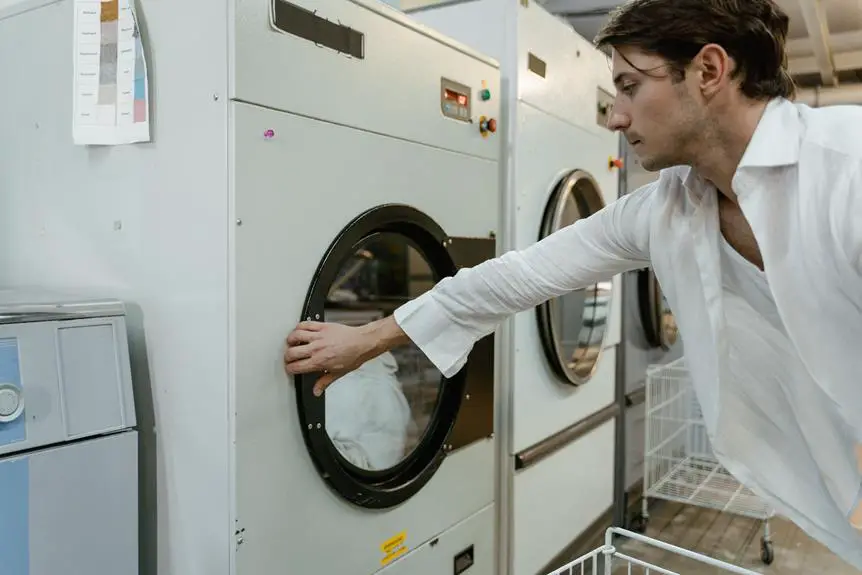If your Roper washer isn't spinning, several issues could be the cause. Common problems include a faulty lid switch that stops the spin when it's open, a broken motor coupler that connects the motor to the transmission, an overloaded or unbalanced drum, a worn drive belt, or a blocked drain pump.
These parts are essential for the washer's operation. To fix the issue, start by checking the power supply, then examine each mechanical part. If the issue is complex, consider contacting a professional for a safe and proper repair.
Troubleshooting Power Issues
When troubleshooting a Roper washer that won't spin, start by checking the electrical outlet and power cord for damage or disconnection. If the power cord is damaged, it may not transmit power to the washer. Examine the plug and cord for wear, fraying, or scorch marks. If the cord is intact, test the outlet with another device to determine if the problem is with the outlet or the washer.
Ensure the power switch on the washer is turned on. A faulty switch or loose connection can prevent the washer from starting the spin cycle.
Check the lid switch, which is a safety feature that stops the washer from spinning when the lid is open. If this switch is broken or not contacting properly, the washer will not spin. Adjust the lid for a proper closure or replace the lid switch if it's defective.
Inspecting these components is essential in identifying the cause of a Roper washer not spinning and addresses common electrical issues that may affect the washer's operation.
Assessing Load Balance
An unbalanced load is often the cause of a Roper washer not spinning correctly. Clothes not evenly spread in the top load washer's tub can disrupt the spin cycle, especially if the load is too small or heavy items are not mixed with lighter ones. This imbalance can cause excessive vibration or the washer to stop to avoid damage.
To check the balance of your Roper washer, inspect the tub's contents. Ensure there's enough laundry to tumble properly. Do not wash single heavy items like a big towel or blanket alone, as it may cause balance issues. Avoid overloading as well.
When filling the washer, combine large and small items to evenly distribute weight during spinning. If the washer becomes unbalanced, pause it, open the lid, and rearrange the items evenly. Then, close the lid and resume the spin cycle.
If balancing the load does not resolve the spinning problems, further inspection of other parts, such as the lid switch or drain pump, may be necessary. However, keeping a balanced load is an important first step in troubleshooting a non-spinning Roper washer.
Checking the Lid Switch
A malfunctioning lid switch often causes a Roper washer not to spin, requiring inspection. The lid switch is a safety feature that keeps the lid shut during spinning. If it's not working, the spin cycle may not start or may stop unexpectedly.
Signs of a faulty lid switch may be deceptive, with other cycles working but the spin cycle failing. Even if the washer drains and spins with less water, the lid switch could still be at fault.
To check the lid switch, disconnect the washer from power first. Find the switch under the lid or along the door frame and look for damage or loose parts. You can also press the switch to check for a clicking sound that indicates it's working. If there's no click or visible damage, the switch probably needs replacing. Consult a professional for safe replacement if needed.
Inspecting the Drive Belt
After checking the lid switch, examine the drive belt for wear or damage which may affect the spinning of your Roper washer. The drive belt links the motor to the transmission, allowing the tub to spin. It can wear out or become misaligned over time, leading to washer malfunctions.
Before inspecting the drive belt, unplug the washer and ensure it is stable to avoid accidents. Look for signs of wear such as fraying, cracks, or glazing on the belt. These indicate that the belt is failing and may not grip properly to rotate the drum. Also, check for stretching that can cause the belt to lose necessary tension.
Verify that the drive belt is aligned correctly and not slipping off the pulleys. Misalignment can lead to slippage or a squealing noise during operation. Realign the belt as per the manufacturer's guidelines if needed.
If the drive belt is worn, damaged, or lacks tension, replace it. A new belt will re-establish the connection between the motor and transmission, enabling the washer to spin properly. After installing a new belt, check its functionality and condition to ensure it is not the reason for the washer's spinning issues.
Evaluating the Motor Coupling
A non-spinning washer may be due to a failed motor coupling, which links the motor to the transmission and protects against damage from heavy loads or blockages. Wear or excess stress can break the motor coupling, affecting the washer's spin or agitate functions.
To inspect the motor coupling, remove the washer's cabinet, a process that might require technical knowledge. Consult the service manual or contact an expert if needed. After cabinet removal, bypass the lid switch to test the motor during the spin cycle.
If the motor hums but does not spin, the thermal safety device may have activated, suggesting a motor coupling issue. Visually inspect for wear or damage on the drive block, clutch, and motor, as these parts can impact the motor coupling's performance.
Replace a defective motor coupling to ensure proper washer operation. Also, check that the drain pump is clear to prevent spinning problems. If unsure about these procedures, seek professional help to prevent further washer damage.
Testing the Drain Pump
Test the drain pump of your Roper washer if it's not spinning correctly. The drain pump removes water during the rinse cycle. A malfunction or blockage can cause issues. Before testing, unplug the washer for safety and remove the cabinet to access the pump, typically connected to the motor. Detach the pump, watching for spilled water.
To perform a test cycle, bypass the lid switch after removing the pump. Run the washer on agitate or spin cycle. If it works without the pump, the pump might be the issue. Examine the pump and connected hoses for blockages, clearing any found.
If the pump is clear, the motor may be faulty. A malfunctioning motor can cause spinning problems. Replace a defective drain pump or motor.
If unsure about conducting these tests or repairs, seek a professional's help or refer to online resources for DIY guidance.





